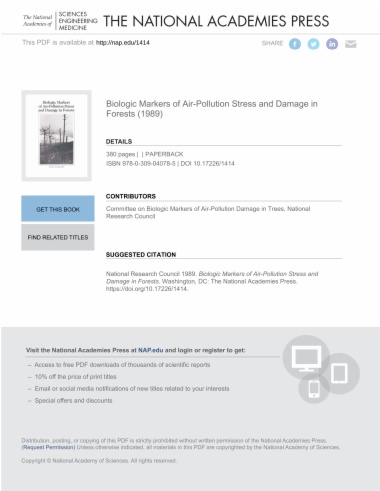There is not much question that plants are sensitive to air pollution, nor is there doubt that air pollution is affecting forests and agriculture worldwide. In this book, specific criteria and evaluated approaches to diagnose the effects of air pollution on trees and forests are examined.
- Cover
- Front Matter
- Executive Summary
- Introduction
- Using Markers in Combination
- The Workshop
- Establishing Cause-and-Effect Relationships
- Using Markers in Surveys and Experimental Studies
- A Strategy for Using Biologic Markers of Stress in Forests
- Conclusions and Recommendations
- References
- Part II: The Workshop Papers: Introductory Session
- Air-Pollutant Distribution and Trends
- Elevational Gradients/Local Chemistry
- Large-Scale Monitoring
- Use of Biomarkers to Monitor Forest Damage in Europe
- Bioindicators in Air Pollution Research - Applications and Constraints
- New and Emerging Technologies
- Forest Applications of Biologic Markers: Regional Session
- Decline of Red Spruce in the Northern Appalachians: Determining if Air Pollution is an Important Factor
- Forest Applications of Biomarkers in Southeastern Forests
- Biomarkers for Defining Air Pollution Effecs in Western Coniferous
- Symptoms as Bioindicators of Decline in European Forests
- Tree-Stand/Ecosystem Session
- Resource Allocation in Trees and Ecosystems
- Markers of Air Pollution in Forests: Nutrient Cycling
- Human Perturbation of C, N, and S Biogeochemical Cycles: Historical Studies with Stable Isotopes
- Tree-Ring Analysis as an Aid to Evaluating the Effects of Air Pollution on Tree Growth
- Evaluation of Root-Growth and Functioning of Trees Exposed to Air Pollutants
- The Use of Remote Sensing for the Study of Air Pollution Effects in Forrests
- Indigenous and Cultivated Plants as Bioindicators
- Experiments and Observations on Epiphytic Lichens as Early Warning Sentinels of Forest Decline
- Fungal and Bacteria Symbioses as Potential Biological Markers of Effects of Atmospheric Deposition on Forest Health
- Microbial and Rhizosphere Markers of Air Pollution Induced Stress
- Biochemical/Cell-Tissue Session
- Foliar Nitrate Reductase: a Marker for Assimilation of Atmospheric Nitrogen Oxides
- Free-Radical Mediated Processes as Markers of Air Pollution Stress in Trees
- Biochemical Indicators of Air Pollution Effects in Trees: Unambiguous Signals Based on Secondary Metabolites and Nitrogen in Fast-Growing Species
- Metals in Roots, Stem, and Foliage of Forest Trees
- The Potential of Trees to Record Aluminum Mobilization and Changes in Alkaline Earth Availability
- Carbon Allocation Processes as Indicators of Pollutant Impacts on Forests Trees
- Photosynthesis and Transpiration Measurements as Biomarkers of Air Pollution Effects on Forests
- Nutrient-Use Efficiency as an Indicator of Stress Effects on Forest Trees
- Leaf Cuticles as Potential Markers of Air Pollution
- Air Pollutant-Low Temperature Interactions in Trees
- Alteration of Chlorophyll in Plants Upon Air Pollutant Exposure
- Co-occurring Stress: Drought

